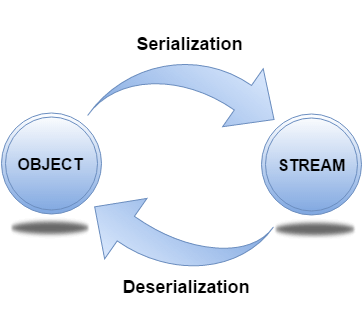Serialization and Deserialization in JavaSerialization in Java is a mechanism of writing the state of an object into a byte-stream. It is mainly used in Hibernate, RMI, JPA, EJB and JMS technologies. The reverse operation of serialization is called deserialization where byte-stream is converted into an object. The serialization and deserialization process is platform-independent, it means you can serialize an object on one platform and deserialize it on a different platform. For serializing the object, we call the writeObject() method of ObjectOutputStream class, and for deserialization we call the readObject() method of ObjectInputStream class. We must have to implement the Serializable interface for serializing the object. Advantages of Java SerializationIt is mainly used to travel object's state on the network (that is known as marshalling). 
java.io.Serializable interfaceSerializable is a marker interface (has no data member and method). It is used to "mark" Java classes so that the objects of these classes may get a certain capability. The Cloneable and Remote are also marker interfaces. The Serializable interface must be implemented by the class whose object needs to be persisted. The String class and all the wrapper classes implement the java.io.Serializable interface by default. Let's see the example given below: Student.java In the above example, Student class implements Serializable interface. Now its objects can be converted into stream. The main class implementation of is showed in the next code. ObjectOutputStream classThe ObjectOutputStream class is used to write primitive data types, and Java objects to an OutputStream. Only objects that support the java.io.Serializable interface can be written to streams. Constructor
Important Methods
ObjectInputStream classAn ObjectInputStream deserializes objects and primitive data written using an ObjectOutputStream. Constructor
Important Methods
Example of Java SerializationIn this example, we are going to serialize the object of Student class from above code. The writeObject() method of ObjectOutputStream class provides the functionality to serialize the object. We are saving the state of the object in the file named f.txt. Persist.java Output: success Example of Java DeserializationDeserialization is the process of reconstructing the object from the serialized state. It is the reverse operation of serialization. Let's see an example where we are reading the data from a deserialized object. Deserialization is the process of reconstructing the object from the serialized state. It is the reverse operation of serialization. Let's see an example where we are reading the data from a deserialized object. Depersist.java Output: 211 ravi Java Serialization with Inheritance (IS-A Relationship)If a class implements Serializable interface then all its sub classes will also be serializable. Let's see the example given below: SerializeISA.java Output: success 211 ravi Engineering 50000 The SerializeISA class has serialized the Student class object that extends the Person class which is Serializable. Parent class properties are inherited to subclasses so if parent class is Serializable, subclass would also be. Java Serialization with Aggregation (HAS-A Relationship)If a class has a reference to another class, all the references must be Serializable otherwise serialization process will not be performed. In such case, NotSerializableException is thrown at runtime. Address.java Student.java Since Address is not Serializable, you cannot serialize the instance of the Student class. Note: All the objects within an object must be Serializable.Java Serialization with the static data memberIf there is any static data member in a class, it will not be serialized because static is the part of class not object. Employee.java Java Serialization with array or collectionRule: In case of array or collection, all the objects of array or collection must be serializable. If any object is not serialiizable, serialization will be failed. Externalizable in javaThe Externalizable interface provides the facility of writing the state of an object into a byte stream in compress format. It is not a marker interface. The Externalizable interface provides two methods:
Java Transient KeywordIf you don't want to serialize any data member of a class, you can mark it as transient. Employee.java Now, id will not be serialized, so when you deserialize the object after serialization, you will not get the value of id. It will return default value always. In such case, it will return 0 because the data type of id is an integer. Visit next page for more details. SerialVersionUIDThe serialization process at runtime associates an id with each Serializable class which is known as SerialVersionUID. It is used to verify the sender and receiver of the serialized object. The sender and receiver must be the same. To verify it, SerialVersionUID is used. The sender and receiver must have the same SerialVersionUID, otherwise, InvalidClassException will be thrown when you deserialize the object. We can also declare our own SerialVersionUID in the Serializable class. To do so, you need to create a field SerialVersionUID and assign a value to it. It must be of the long type with static and final. It is suggested to explicitly declare the serialVersionUID field in the class and have it private also. For example: Now, the Serializable class will look like this: Employee.java
Next TopicTransient Keyword in java
|
 For Videos Join Our Youtube Channel: Join Now
For Videos Join Our Youtube Channel: Join Now
Feedback
- Send your Feedback to [email protected]
Help Others, Please Share









